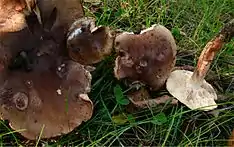Tricholoma ustaloides
Tricholoma ustaloides is a species of mushroom in the large genus Tricholoma. It has a widespread distribution in Europe, where it is typically found in association with oak and beech trees. Although generally considered inedible, it is consumed by some in Mexico.
| Tricholoma ustaloides | |
|---|---|
 | |
| Scientific classification | |
| Kingdom: | |
| Division: | |
| Class: | |
| Order: | |
| Family: | |
| Genus: | |
| Species: | T. ustaloides |
| Binomial name | |
| Tricholoma ustaloides Romagn. (1954) | |
| Tricholoma ustaloides | |
|---|---|
float | |
| gills on hymenium | |
| cap is convex | |
| hymenium is adnexed or adnate | |
| stipe is bare | |
| spore print is white | |
| ecology is mycorrhizal | |
| edibility: inedible | |
Description
The cap is red-brown or chestnut-brown with a paler margin, very sticky when moist, and has a diameter of 4 to 8 cm (1.6 to 3.1 in).[1] The overall shape of the cap is bell-like when young, later flattening to a more irregular convex shape in maturity, and often developing a lobed appearance. The margins of the caps are usually turned inwards. The gills are crowded together, adnate or emarginate in attachment to the stipe, and white or a light ochraceous yellow with dark brown stains when old or bruised. The stipe is 4 to 10 cm (1.6 to 3.9 in) long by 1 to 2 cm (0.4 to 0.8 in) thick, roughly spindle-shaped (fusiform), with red-brown fibrils and a sharply defined zone of white color at the stalk apex, especially in more mature specimens.[2] The flesh is white or cream, smelling strongly of meal, with a bitter taste.[3][4]
Spores have a roughly spherical or ellipsoid shape, are hyaline, smooth, non-amyloid, and have dimensions of 5.5—7.0 x 4.5—5.5 µm.[1] Basidia are 4-spored and cystidia are absent.[4]
Habitat and distribution
This mycorrhizal species typically grows in small groups, and is often found near trees in the genera Quercus and Fagus.[1]
Although relatively rare, it has a widespread distribution in Europe, limited by the presence of its preferred tree hosts. Its first recorded appearance in Mexico was 1984.[5]
Edibility
Despite its inedible status by some sources,[2][4] Tricholoma ustaloides is consumed by the inhabitants of Ajusco and Topilejo, communities near Mexico City.[6]
See also
- List of North American Tricholoma
- List of Tricholoma species
References
- Bas, Cornelis (1988). Flora agaricina Neerlandica: critical monographs on families of agarics and boleti occurring in the Netherlands. Rotterdam: A.A. Balkema. p. 127. ISBN 90-5410-492-9.
- Arora, David (1986). Mushrooms demystified: a comprehensive guide to the fleshy fungi. Berkeley, Calif: Ten Speed Press. p. 185. ISBN 0-89815-169-4. Internet Archive
- Gryzyby―Fungi of Poland
- Jordan, Michael (1995). The encyclopedia of fungi of Britain and Europe. Newton Abbot: David & Charles. p. 183. ISBN 0-7153-0129-2. Google Books
- Aroche RM, Cifuentes J, Lorea F, Fuentes P, Bonavides J, Galicia H, Menendez E, Aguilar O, Valenzuela V. (1984). "Toxic and edible mushrooms in a community of the Valley of Mexico 1". Boletin de la Sociedad Mexicana de Micologia 19: 291—318.
- Reygadas F, Zamora-Martinez M, Cifuentes J. (1995). "Knowledge on wild edible mushrooms in the Ajusco and Topilejo communities near Mexico City". Revista Mexicana de Micologia 11(0): 85—108.